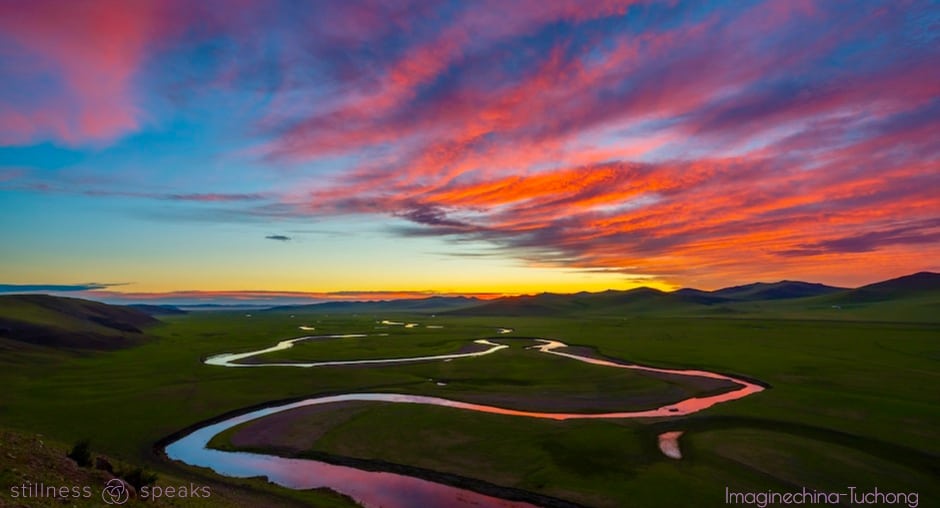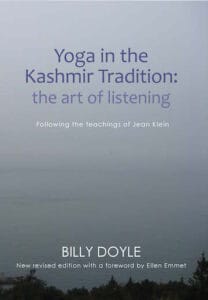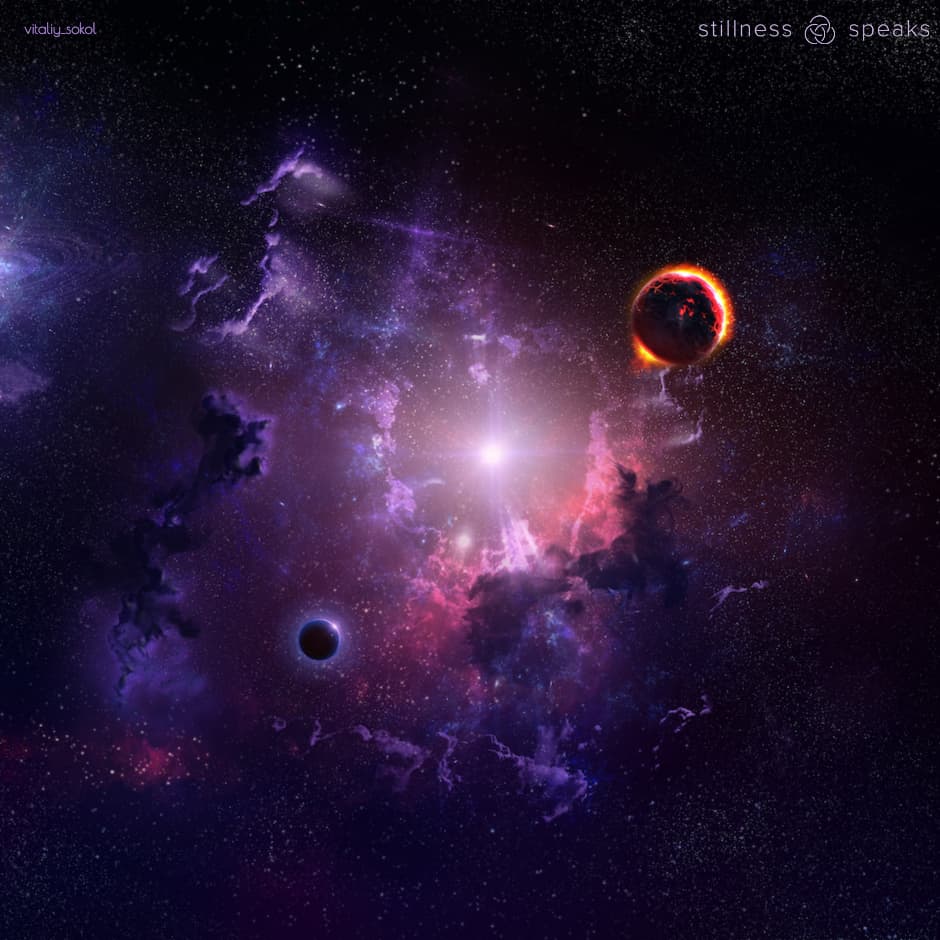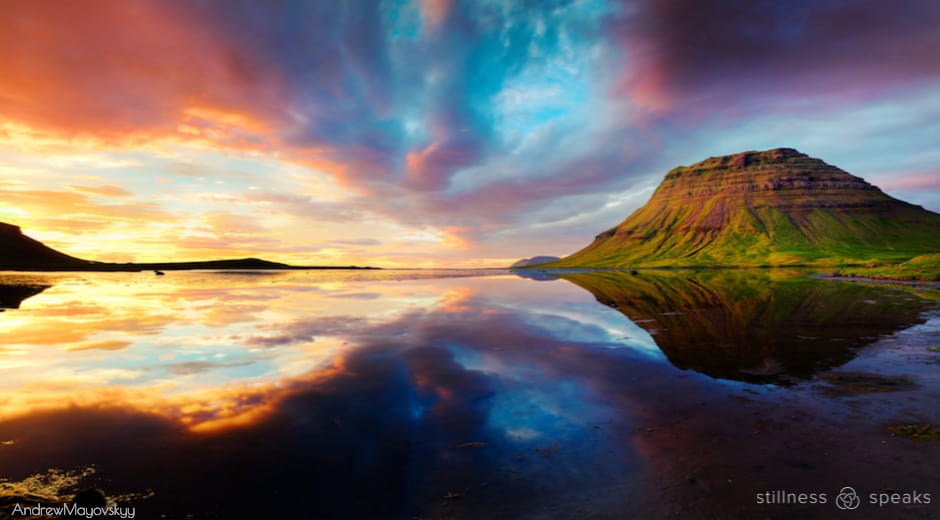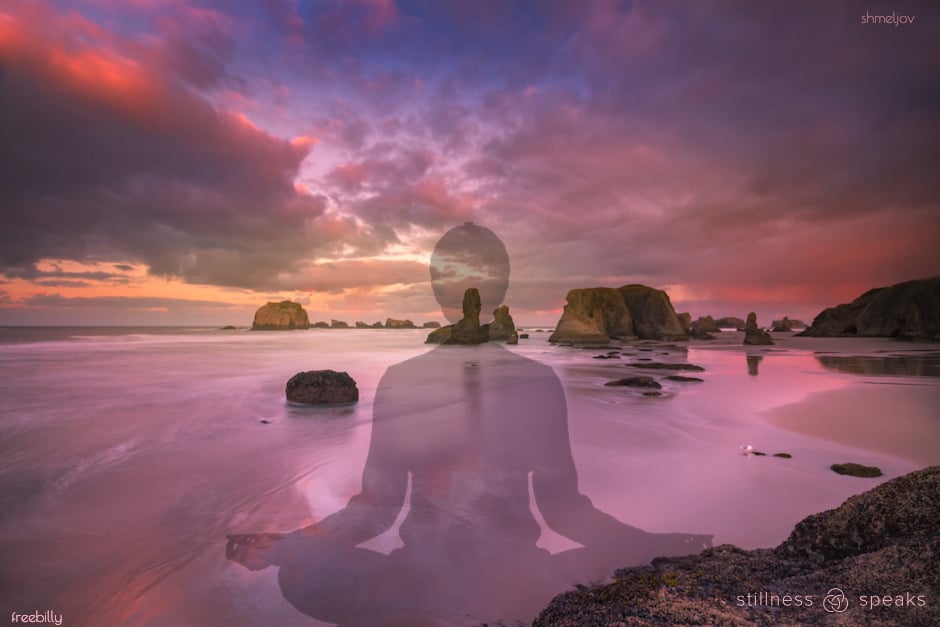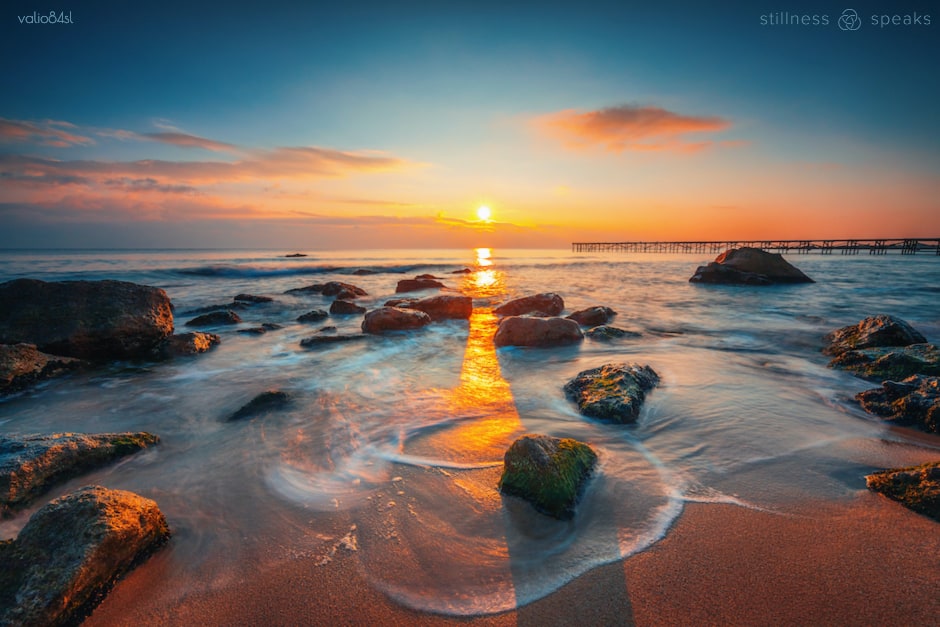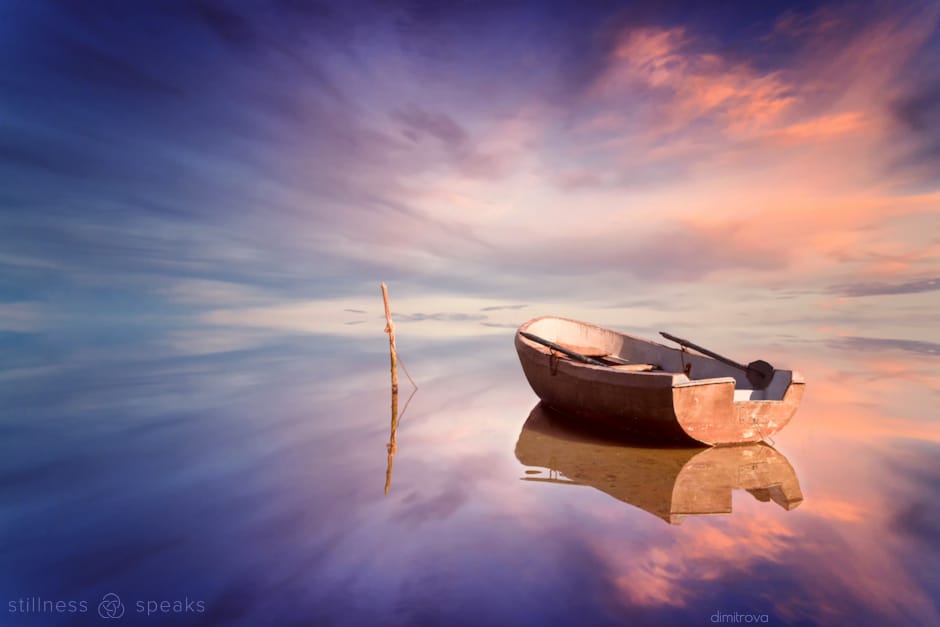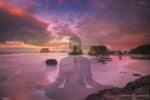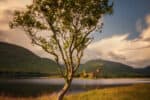Jean Klein’s Teachings: “… It is important to live this directionlessness, this not- knowing, this waiting without waiting for anything. It acts on your cells, on your psychosomatic body, bringing them to dilation and harmony. All that remains is your directionless awareness. Live in this absolute absence of yourself. It is the threshold. You are in complete openness, open to nothing, free from all ideas, free from all hope. And when you are completely transparent, open to openness, you are taken by Truth, by Grace. That is certain. …” ~ Jean Klein
Indeed, Grace with certainty! … what an exquisite summation of Jean Klein’s teachings in his own words! …
As brought to us by Billy Doyle in his 2019 book: Yoga In The Kashmir Tradition: The Art Of Listening – Following The Teachings of Jean Klein …
We offer an in-depth preview of Billy’s book in this 5-part series’ overview post where we offer – via highlights from each of the 5 parts – the essence of Jean Klein’s teachings: a marriage of self-enquiry with body work. Of course, a link to each of the 5 parts is embedded as appropriate.
We set the stage for this exploration with excerpts from Ellen Emmet’s Foreword and Billy’s Introduction … followed by a deeper dive through the entire chapters: Advaita Vedanta, The Art of Listening … followed by partial-chapter excerpts from Listening to the Body, and Meditation. These chapters offer the basis of Jean Klein’s teachings … which Billy adeptly weaves in his deep dive into the various Yoga postures and breathing techniques – each with additional details.
The entire book is an excellent offering for any earnest explorer of Yoga … and, of course, Jean Klein’s teachings.
{All italicized text below is from Billy’s book and is published here with the publisher New Sarum Press’ generous permission. Scroll to the bottom for a free downloadable Table of Contents.}
Jean Klein’s Teachings: Yoga in the Kashmir Tradition
Rumi has the remarkable gift of showing us the Divine in the most mundane to the most sacred … and his poetry is unbridled about “one thing” : your True Nature … and for him this “one thing” holds the ultimate importance: “… The one thing in this world you must never forget to do. If you forget everything else and not this, there’s nothing to worry about, but if you remember everything else and forget this, then you will have done nothing in your life …”
One can claim that Rumi’s exhortation is somewhat easier to embody – in our times – because we are seeing (for some 3-4 decades) a tremendous growth of nonduality spiritual teachers because they are bringing awareness to Rumi’s “one thing” and making it more prevalent (maybe even “acceptable”) in society … BUT an equally valid claim is that there is the natural risk of dilution and its troubling ramifications …
This matter – or the risk – of “dilution” has become exponentially “multiplied” due to the internet being such an essential part of life. As Ellen Emmet eloquently says (in her Foreword to Billy’s book – Part 1 of 5): below are the key highlights from part 1: Foreword & Introduction.
Foreword (Part 1 of 5)
“… As the internet becomes the shrine and anyone who has had a singular awakening experience becomes the guru, the risk arises that the teaching will be watered down or even deadened. …” … {consequently} … “… The living tradition, consisting of the direct transmission of truth and the means to establish oneself there, and carried down through the generations by a lineage of sages, is often discarded or ignored, leaving many frustrated and confused before long …”
With some exceptions, few or no means are provided to investigate the existing or remaining beliefs in separation that continue to rule our lives after a moment of understanding and that seem to obscure the shining of our true nature. Furthermore, many contemporary non-dual offerings misunderstand and therefore neglect the importance of including the body and the realm of feeling and perception in the investigation of such beliefs and conditioning.
In this context, Billy Doyle’s Yoga in the Kashmir Tradition, updated and fleshed out in this second edition, is a great relief and a true gem. It is first and foremost a bow to his teacher, Jean Klein, paying homage to his lineage and the tradition of direct transmission and placing Billy’s own teaching within that sacred current.
Introduction (Part 1 of 5)
With Ellen’s most apropos setting we are ready to dive into Billy’s Introduction – Part 1 of 5:
“… In pure perception we are open to the sense of wonder. More profoundly, when the senses are no longer dominated by mental function and the idea of a separate perceiver, objects are no longer objects; they are extensions of ourselves, expressions of silence …” ~ Billy Doyle
Yoga in the Kashmir Tradition presents yoga as I experienced it working with Jean Klein. Jean brought this approach to the West in the 1950s and during subsequent years he further developed and refined the teaching.
Jean Klein was a master of Advaita Vedanta (non-duality) in the tradition of Ramana Maharshi and Shri Atmananda Krishna Menon; however, he had his own distinctive and unique approach.
…
Here I will be focusing on his teachings regarding yoga, but as the whole sphere of his approach, be it self-enquiry, meditation or body work, was totally integrated, so these different aspects are intertwined through the book.
And again, here’s the complete post: Part 1 of 5.
Advaita Vedanta (Part 2 of 5)
“… When you go beyond awareness, there is a state of non-duality, in which there is no cognition, only pure being. In the state of non-duality, all separation ceases …” ~ Nisargadatta Maharaj
Nisargadatta Maharaj is one of the three great titans of Advaita or nonduality teaching, which classically “comes from” India but this core truth of “oneness” is evident in all traditions as expressed by two examples below:
“The God who existed before any religion counts on you to make the oneness of the human family known and celebrated.” ~ Desmond Tutu
“The first peace, which is the most important, is that which comes within the souls of people when they realize their relationship, their oneness, with the universe …” ~ Black Elk
As Billy noted (above under the Introduction) Jean Klein was an Advaita master with his own distinctive approach and his teachings were infused with that … so as part of this teachings framework, Billy’s chapter Advaita Vedanta – Part 2 of 5 offers his condensation of this tradition (including Jean Klein’s pertinent remarks): below are some key highlights from part 2.
At the core of the great religious traditions there is the understanding of the oneness of the whole of life. In the Indian tradition this is known as advaita, which means ‘not two’. This truth lies at the heart of the Upanishads, and was later expounded by Sri Shankaracarya in the ninth century. Indeed, this is a current running through the whole of Indian culture.
…
We come to understand, and actually feel, that consciousness is non-localised, that all that is perceived is in consciousness. There is not a separate seer and an object seen. The seen is in the seeing; there is no seen without the seeing. All that is perceived is of the very nature of consciousness. Here we stand in freedom, no longer an inside or outside, a separate me and a separate you. It becomes totally clear that my essential nature is unlimited consciousness. All is an expression of love, all is love. All is God, there is nothing but God.
…
Jean’s teaching points directly to the ultimate, but he used elements of the so-called progressive approach in his teaching; these are outlined in this book. From the beginning, he stressed the importance of being open to the possibility that our real nature is timeless, spaceless, and we are not simply a body-mind. Therefore the emphasis is not on attainment, or some spiritual evolution which keeps the ego thriving, it is something much more simple: to see what we are not. What we are fundamentally needs no improvement. It is this insight that leads to a purification that comes, so to speak, from above to transform the whole psycho-somatic level.
And again, here’s the complete post: Part 2 of 5.
Jean Klein’s Teachings: The Art of Listening (Part 3 of 5)
“… In this observing is the total absence of yourself. It is your real presence …” ~ Jean Klein
Jean Klein believed that it’s crucial to look after the body – to keep it “sattvic or pure” … because a sattvic body is much more open to grace. As he said: “… it is rare that one has a glimpse of reality with a conditioned, tamasic body …” …
Through his direct experience Jean knew that Yoga (the exploration of body mind) has the possibility of bringing one back to what he termed “objectless awareness” – to integrate the body into its “original state” (another of his terms) … allowing it to be “sattvic or pure.” He further believed that such “… exploration can only be done at the energy level.” … which leads to the key (maybe even fundamental?) aspect of his teaching: the art of listening … as expressed in his book, The Book Of Listening:
“… Our body is a beautiful musical instrument, like a Stradivarius, but, it must be tuned. We are the tuner. … This beautiful instrument has to be sensed. It is in sensing that we come to the right tuning. It calls for a very high art of listening. … We must become able to listen. Hearing these fine vibrations comes first in meditation. …
… It is tremendous to discover oneself in listening. …
Billy offers his summation of Jean’s key teaching in his chapter The Art of Listening – Part 3 of 5: below are some key highlights from part 3.
At the heart of this approach, whether it concerns self-knowledge or coming to know the body, is how we observe: the art of listening. Normally we conceive of observing as directed to some object, a concentration, but here we allow the object to appear in observation. Listening here does not refer to our ears, or to a cerebral function, but to our total openness. It is not a matter of trying to listen since listening is our natural state, but seeing that we don’t listen.
In unconditioned listening, choiceless listening, we are completely open. It is an openness free of purpose or intent. It is an innocent welcoming of all that appears. It is like a scientist without presuppositions, just open to the facts.
And, again here’s the complete post: Part 3 of 5.
Jean Klein’s Teachings: Listening To The Body (Part 4 of 5)
“… The body is thus a pointer to awareness. The purpose of all objects is to remind us of our real nature: awareness, consciousness … {and} … Ultimately, we come to realise that the body and all manifestation are nothing but awareness. …” ~ Billy Doyle
To embrace Jean Klein’s key teaching – the art of listening – one has to listen to the body. Jean’s likening the body to a beautiful instrument Stradivarius) naturally leads to it requiring tuning (with us being the tuner) to bring about the fruits of the teaching. As he said: “… To tune this instrument … calls for a complete metamorphosis of oneself, and this can only happen when we are one with our instrument, with our body. …” ~ from his classic: The Book Of Listening
And, in Billy’ words: “… by listening we come to tune it, we come to harmonisation …” … so he takes us on a deep dive into Jean’s key teaching of Listening to the body – Part 4 of 5: below are some key highlights from part 4.
Listening begins with the immediate environment, the body. When we come to a freedom in the body we’re more open to listening to our wider environment. Ultimately listening refers to itself, and not to any object of listening; we are the listening.
…
We don’t listen to the body from the head, but from our wholeness. It is impossible to experience the whole body from the head since our head is part of the whole. This listening needs no effort; choiceless listening is the natural function of awareness. Any anticipation or intention only interferes. In anticipation there is end-gaining, becoming; we’re back in the mind, no longer in the moment.
And, again here’s the complete post: Part 4 of 5.
Choiceless Awareness == Meditation (Part 5 of 5)
And, as Jean said in The Book Of Listening “… Our body is a beautiful musical instrument, like a Stradivarius, but, it must be tuned. We are the tuner. … This beautiful instrument has to be sensed. It is in sensing that we come to the right tuning. It calls for a very high art of listening. … We must become able to listen. Hearing these fine vibrations comes first in meditation …” which Billy, explores in his chapter Meditation – Part 5 of 5 : below are some key highlights from part 5.
We can talk about meditation as a practice, but meditation in its deepest meaning is to rest in our real nature, to be what we are—knowingly. It is not a cerebral activity or even a non- activity, it’s beyond all opposites.
We don’t know ourselves in silence, but only through a collection of images, thoughts and feelings. It is the continuous mind-chatter and daydreaming that keep alive this self-image.
And, again here’s the complete post: Part 5 of 5.
All italicized text above (except otherwise noted) is from Yoga In The Kashmir Tradition: The Art Of Listening – Following The Teachings of Jean Klein and is published here with the publisher New Sarum Press’ generous permission.
And click here for a FREE downloadable copy of the Table of Contents, graciously and generously made available by the publisher New Sarum Press.
Jean Klein’s teachings offer us a way to embrace the world – and so-called “others” – and deeply appreciate the oneness of us all … and in that spirit let us minimize (& hopefully dissolve) the current humanitarian crisis unfolding in Ukraine … by helping in whatever way we can … and to that end here are some options:
1) NPR: Want to support the people in Ukraine? Here’s how you can help
2) Washington Post: Here’s how Americans can donate to help people in Ukraine.
3) Go Fund Me: How to Help: Donate to Ukraine Relief Efforts.
4) USA Today: Want to support the people of Ukraine? These apps and websites can help you send money.
— — — —
We are all facing financial challenges but IF your situation allows you to donate and help then please do so …
THANK YOU!
And, may your life be infused with Jean’s art of listening … and …
May you remain safe and healthy as you navigate these unsettling times.
